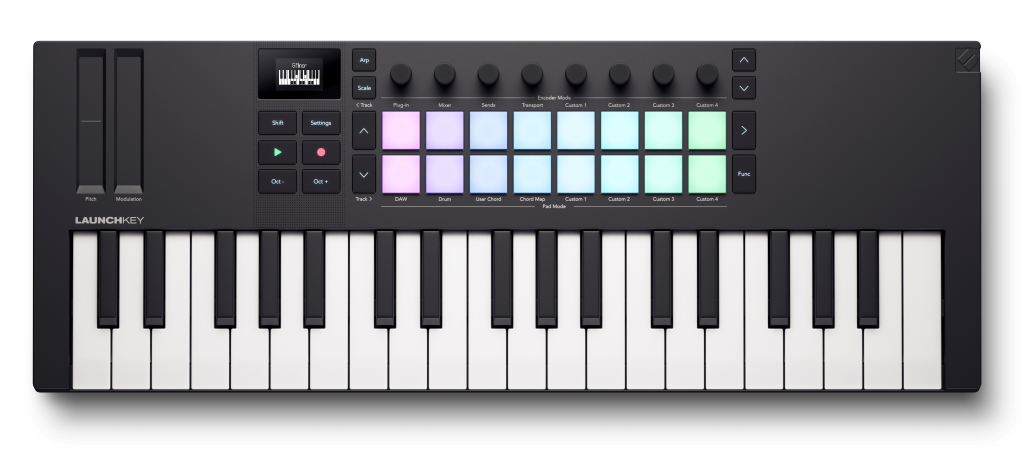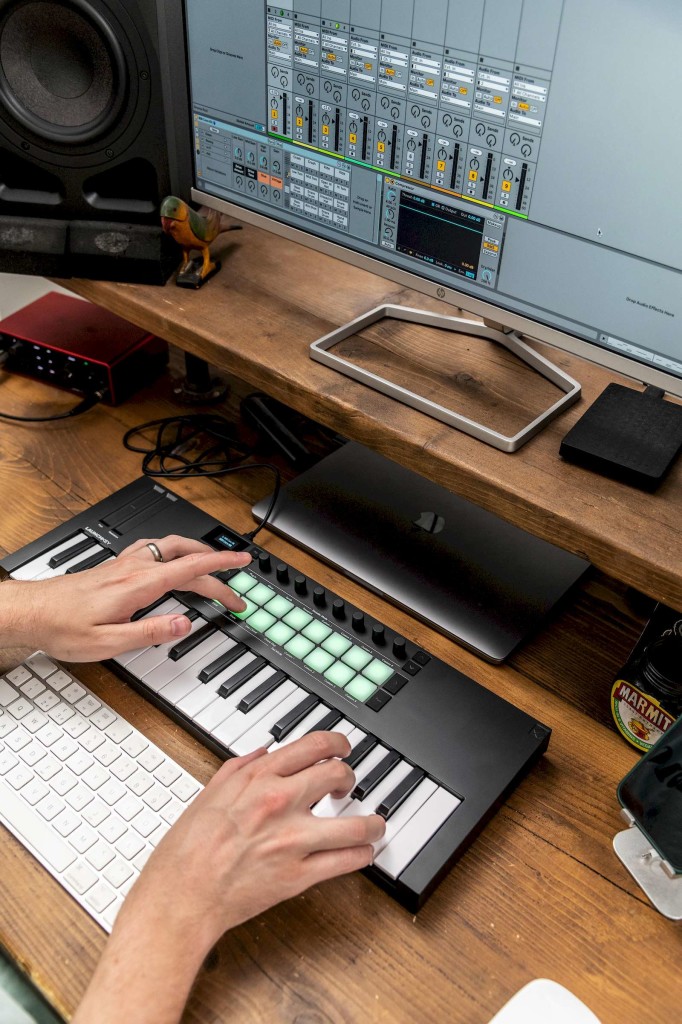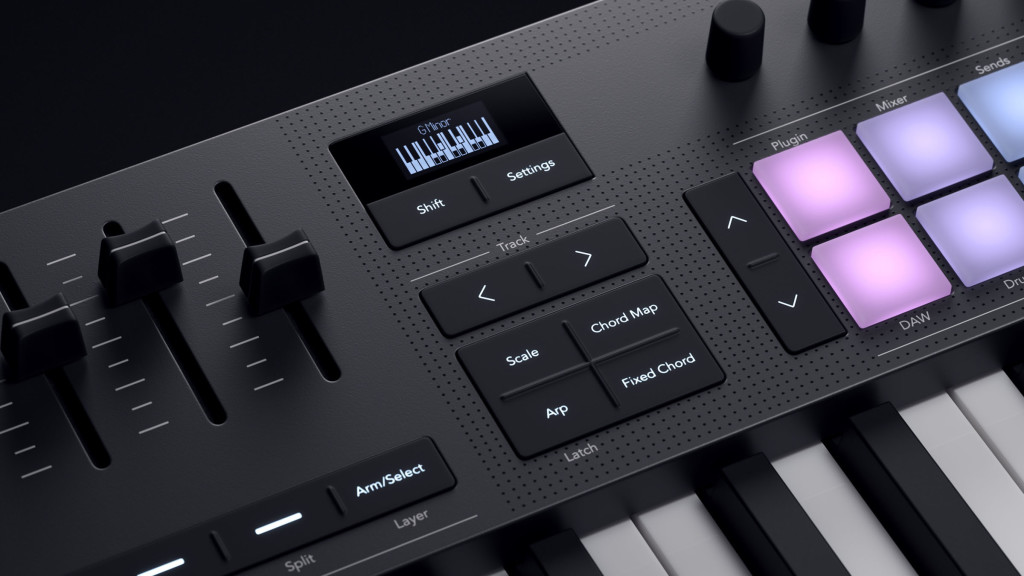Novation’s MK4 Launchkeys keyboard line is here. Available in an array of options, from mini keys to piano keys, they all have one thing in common. Imagine a bite-sized version of some of the favorite control and jamming features of tools like Ableton Push — in a keyboard.
Keyboard controllers with software integration have been evolving for a long time now. Novation has contributed to that more than just about anyone, back to their ReMOTE range. But the industry has also gotten better at making hardware that lasts and integration that’s easy to understand.

Hardware features
I’ve been testing the version I know a lot of you have your eyes on – the ultra-portable Launchkey Mini 37 – through Novation’s beta period. And this is a remarkably elegant, mature little keyboard. The mini key keybed is surprisingly playable and, crucially, consistent. (I haven’t gotten to test the full-sized and full-sized semi-weighted piano options yet.) It’s the sort you want to keep handy right next to your computer keyboard all the time. And I’m obsessed enough with improvising on the go that I’ll even lie in bed with my MacBook or sit crammed into coach on a bus or plane and key stuff in on the QWERTY. This fits that role well. This is simply the best portable mini keyboard I’ve played and the best portable controller.

Across the range, you get a well-balanced feature set, including some additions you might not have expected, like polyphonic aftertouch on the pads (!):
- 16 velocity-sensitive pads with polyphonic aftertouch (yeah, even on my mini) and a unique design (which Novation says they’ve patented)
- An option of waterfall keys at the high end down to “responsive and sensitive” mini keys. Note that there is polyphonic aftertouch on the pads but not on the keys, not even channel aftertouch. (Though at the price, I think that’s not a deal killer.)
- Eight encoders
- Nine faders (49- and 61- key models only)
- Scale Mode with basic scale options
- Arpeggiator with tempo (internal and external), rate (1/4 – 1/32 with triplet options), gate, swing, type/direction (up, down, up/down, as played, random, chord, strum), octave, mutate (7 additional variations with encoder control), rhythm, pattern mode, tie, accent, ratchet, more
- Chord mode, which integrates with the performance pads, offers various presets and Church modes, user chords, and arp integration.
- Chord Detector with visual feedback
There’s also quite a nice software bundle, including GForce Oberheim SEM, OB-EZ, and AXXESS (exceptional already), some beautiful Orchestral Tools software, a few from Klevgrand, and even Melodics lessons in case you want to work on your chops. Oh, and there’s Ableton Live 12 Lite, though anyone reading this article will likely ignore that. (The other freebies are a rare case of stuff in a budget keyboard you’ll actually use!)
On the Mini I tested, you get a cute little OLED display. Yeah, it’s the same one we’ve seen all over the industry lately. It works as you’d expect, and even with some vision loss, I was able to read it easily.

I just can’t force myself to use scale modes – they’re just too confusing when you have played pianos and keyboards. The chord mode I tend to feel the same way, but here with the pad and arpeggiator integration, they get interesting.
The arpeggiator here is another matter. A keyboard arpeggiator needs to be good when using your keyboard with a DAW because it has to compete with everything your software can do. But here, the combination of hands-on control, easy tempo sync, and some really clever options make this the best keyboard arp I’ve seen yet.
And mark that as the first area where Launchkey feels like a keyboard counterpart to Ableton Push.

DAW integration
You’re buying a Launchkey primarily for one reason: you want Launchpad-style integration with your favorite software. Novation has again nailed it with a balanced combination of keys, pads (to use both as triggers and for controlling of clips in software), and encoders and/or faders.
There are other keyboards with pads and keys, but the other clever design from Novation is all around its pad shift functions. Without adding too much confusion, this allows you to easily swap pad modes between DAW, drum, and chord or arp controls, use encoders for the mixer, sends, or plugins, and even use advanced custom modes (four each!) for the pads and encoders. You can also double-press to latch modifiers, which is both an accessibility feature and, you know, less annoying.
The modifiers solve the major annoyance of most competing controllers: no more having to choose between DAW integration and playing. I really hated that about a lot of keyboards: you’d get DAW integration working and lose other features.
No more having to choose between DAW integration and playing.
The DAW integration is superb. I’m sure some of you will be disappointed that your favorite DAW isn’t specifically included—at launch, you get Ableton Live, Logic Pro, FL Studio, Reason, and Cubase. But Novation has done an exceptional job with the tools it has chosen, and I expect intrepid users will find ways to customize the hardware for other software. There’s also full MCU/HUI compatibility, which means you’ll get fairly complete mix and transport control of the vast majority of other DAWs. You also have switchable user MIDI templates you can assign to software or hardware connected to your computer for even more custom control – four each for the pads and encoders.
Here’s a quick rundown of what you get in different software as far as tailored support:

Across all DAWS: Navigate tracks, control mixer (level, pan, send), transport (play and loop but also scrubbing and playback position), zoom, set loop in and out, set and select markers, plus play drums, toggle metronome, quantize, undo/redo, arming, and Capture MIDI.
Yeah, wow. And that’s the generic functionality – meaning, for instance, Ableton-style MIDI capture now works in DAWs that don’t make that same feature obvious (like Logic or Cubase).
Ableton Live: Device control, moving between clips (with focus ring), changing devices, zooming both horizontally and vertically, sequencing MIDI clips, and launching clips. You can also set the pads to mute, solo, stop, etc. It’s frankly easier for some cases than Push. (Sorry!)
You also have direct control over Ableton Live’s clip sequencers, with specialized melody and drum sequencers for Launchkey, as well as control of velocity, length (coarse and fine), and nudge.
You also have direct control over Ableton Live’s clip sequencers.
Logic Pro: Smart Controls map directly to the encoders, which actually makes these way more useful. EQ modes map automatically. You can use pads with Live Loops for the Ableton-style control you’d expect, for both clips and scenes. And as with Live, you can also map pads to track settings.
By the way, Smart Controls are an underrated feature. In addition to the library of layouts Apple provides, which has grown over time, you can indeed create your own custom layouts, just as with macro/rack layouts in other tools. (Despite how the narration begins in that video, Smart Controls are closest to what Apple did with MainStage controls, but if you’re migrating from Live, thinking of them as roughly akin to the Rack layouts makes sense.)
Cubase: Cubase’s Plugin Encoder mode and Quick Controls get assigned here. And you can use Cubase’s excellent EQ, though I’d love to see integration with some of their other plugins in the future. DAW pads are limited to select, arm, mute, and solo. But I’m not complaining because of the common features above (which also means if you start projects in Live and finish them in Cubase, this keyboard excels).
FL Studio: Most native FL plugins work with the encoders straight out of the box. You also can control Channel Racks and Mixer EQ. The DAW pads here act as Channel Rack selectors. Now, Novation makes a dedicated FL keyboard called FLkey, but the new hardware and integration might make you opt for this instead, honestly, even without the specialized FL features. I didn’t get much time to test with FL Studio, and I wish that the FLkey integration had made it here – I’ll follow up with Novation about that. It feels a bit like something is missing here in that the Sequencer Mode and its integrations with SliceX, etc., seem like a natural fit.
Reaason: I actually enjoyed this the most in Reason, after Ableton Live. I owe you a Reason 12 review, so I’ll look at that separately.
I’ll go into customization more later, but suffice to say Novation has some of the best tooling for customization in the business, thanks to their browser-based Components tool. (You can now download Components, too, if you were frustrated in the past with having to be online.)
Conclusions
The package and pricing here is terrific. And it’s tough to compete with Novation’s fantastic software integration, especially for Live and Logic, but also across the exceptional DAW control range here.
There are way more than enough choices in keyboard controllers so that no one keyboard has to fit everyone. If your emphasis is on DAW integration and balancing control via pads and keys, this is a real sweet spot. You don’t get much in the way of I/O (one MIDI DIN on the bigger models), and you don’t get channel aftertouch – so for that, you might look elsewhere. (Rival Arturia has a big display, channel aftertouch, and more I/O on their KeyLab MK3, for instance.)
But as a bread-and-butter controller keyboard, the Launchkey is terrific, especially the Mini 37 I tested.(Arturia again is my main competition, as their MiniLab 3 has faders and the Launchkey doesn’t. I’m keeping both for the moment.) It’s also an unusually affordable way to get a keyboard with semi-weighted, waterfall action – if you don’t mind the lack of channel aftertouch.
And it’s tough to beat Novation’s DAW control and arpeggiator/pattern functionality. For me, I’ve found I’ve been keeping it handy right alongside my mouse and QWERTY keyboard/
https://novationmusic.com/launchkey
Pre-production evaluation: For this review, I tested release candidate software and integration scripts. This may not entirely reflect final hardware and software. The release candidate should be the same as what you download today, but the engineering sample I used was pre-production.
Street price for the Launchkey range runs from about US$119 for the Mini ($149 for my Mini 37 as tested) up to a very reasonable $299 street for the waterfall action. Available from retailers (Mini models on preorder)
If you buy something from a CDM link, we may earn a commission.
Novation Launchkey MK4 at Perfect Circuit
Novation Launchkey MK4 at Guitar Center
Novation Launchkey MK4 at Sweetwater
Here’s loopop with a review and tutorial – and some nice music, as well: